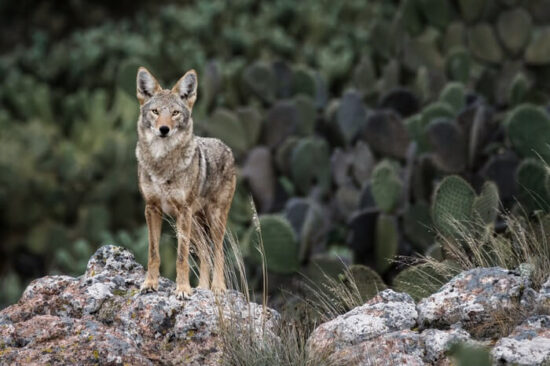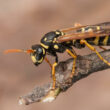There’s a lot of misinformation that gets shared about the sleep patterns of coyotes. You’ll often get completely different answers if you ask people when these animals hunt, if they come out during the day, or if they’re nocturnal.
Don’t worry, this guide will set the record straight.
Table of contents
When Do Coyotes Hunt?
Contrary to popular belief, coyotes don’t always reserve their hunting hours for the dead of night. These wild canines are opportunistic feeders. They require food every day and will actively pursue prey whenever they get the chance.
If an opportunity to eat presents itself, it doesn’t matter if it’s day or night. Coyotes will jump into action to stay alive!
All that said, coyotes seem to spend most of their time hunting during the early morning and late evenings. Some variation in hunting schedules can exist based on location and daylight savings hours. However, most coyotes will use those short windows of subdued lighting to find food.
Quick Tip: Curiously, those habits aren’t due to evolution or survival instincts. It all comes down to when their prey is most active! Technically speaking, coyotes are omnivores. However, a significant portion of their diet is animal meat.
As mentioned earlier, coyotes are opportunistic feeders that will eat just about anything. But, they prefer common prey animals like whitetail deer, rabbits, and rodents. These animals come out of the shadows once the sun starts to wane, leading to a treasure trove of potential food.
Coyotes follow suit, hunting these prey animals once they go out in the open. Despite what many believe, coyotes don’t hunt in large packs. They usually stick to themselves or hunt in small family groups.
Most people don’t see coyotes out and about because they stick to the dawn and dusk hours to hunt. You might hear their signature yip howls as they feast, but these animals do an excellent job of hunting discreetly.
Do Coyotes Come Out During The Day?
Coyotes are pretty misunderstood as far as lifestyle goes. One of the biggest misconceptions out there is that coyotes are purely nocturnal (more on that later). Because they tend to hunt when the sun dips below the horizon, people treat daytime sightings as an unusual event.
Like daytime sightings of raccoons, many assume that day-roaming coyotes are rabid and dangerous. However, that’s not always the case!
Coyotes can and do come out during the day. It’s perfectly normal and in line with the predator’s lifestyle. Those sightings only seem rare because coyotes actively avoid human detection.
You see, coyotes are naturally diurnal. Their internal clocks are in sync with the day and night cycle. It’s the same way of living as a human!
These predators rely on many senses to navigate the world and find food. In addition to smell and hearing, sight plays a big part. While they have special receptors to see better in the dark, daylight is still helpful for hunting.
So why don’t we see more coyotes during the daytime?
Believe it or not, coyotes adapt to human schedules to avoid detection! The canine’s adaptation varies based on its proximity to humans.
For example, coyotes in more rural areas tend to be bolder in their daytime activities. There are fewer people around, making it safer to roam without the worry of detection or possible harm.
On the other hand, coyotes in urban settings are more discrete. These coyotes know that there’s a good chance that they’ll be detected when they explore during the day. So, they adopt a more crepuscular circadian rhythm to avoid conflict with humans or other would-be predators.
It’s a fascinating example of evolution in the animal kingdom and shows just how far these creatures are willing to go to stay alive in the face of human development. Even as they lose their natural habitat to new neighborhoods and vast urban expansion, coyotes are smart enough to evade detection and stay safe!
Are Coyotes Nocturnal?
Coyotes are often misidentified as nocturnal animals. While they can undoubtedly exhibit nocturnal behaviors, coyotes are not nocturnal like owls or bats. They adapt to their surroundings and modify their circadian rhythm to stay safe.
Quick Tip: These animals can act nocturnal if their environment calls for it, but their natural lifestyle is more like a human’s than anything else. Coyotes respond to threats like humans and other larger predators. When those dangers are present, coyotes will do all they can to avoid them!
In the wild, coyotes are far from human civilization. As a result, they will spend their days living life as usual. Their diurnal tendencies come out in full force, and they don’t feel the need to go into hiding when the sun is out.
However, that changes when coyotes live closer to humans. They adapt to the ever-present danger. As stated earlier, wild coyotes are most likely to hunt during the short periods of dawn or dusk to avoid detection and conflict.
That’s also when most of their preferred prey is out in the open, so they take advantage of the window of opportunity to get food. Because these animals go into the open as most humans settle down for the evening, many assume that coyotes are purely nocturnal.
That’s not the case.
It all comes back to evading human conflict. Coyotes can behave more nocturnal if they need to stay safe. Those in larger urban environments wait a little longer to come out of hiding, forcing them to adopt a more nocturnal lifestyle. Meanwhile, those in rural areas with fewer humans around will spend more time hunting in the daylight.
Where Do Coyotes Go During The Day?
If they’re not out and about, where are coyotes spending most of their day?
Usually, coyotes will sleep in areas that are covered and protected. They stick to forests with tons of dense vegetation. Shrub-covered patches of land are popular with coyotes, too.
Generally, any spot that keeps the animal free from detection is ideal. Forested areas are the go-to for most when they’re available, as it gives the canines freedom to move around rather than stay in one spot all day.
As night falls, many coyotes move into more open lands with sparse vegetation. For example, they might roam into backyards, parks, and other areas they couldn’t venture into during the day.
Quick Tip: While they do have more freedom to roam, coyotes are smart enough not to venture too far. According to a study performed in Washington state, coyotes show a habit of traveling no farther than one hour from a “safe spot.” The canines make sure that they have a nearby haven to sleep and hide if they encounter humans or predators.
Another big misconception about coyotes is that they live (and sleep) in dens. Coyotes aren’t as social as they appear to be. As a result, they don’t sleep in shared caves unless it’s during the pup-rearing season.
When they’re raising young, coyotes will search for pre-dug dens to take over. Usually, these dens were previously used by other animals like skunks or badgers. The coyotes over and widen the space to meet their needs.
Denning is temporary and only lasts as long as the female needs it to raise her young. Once that’s over, she’ll move on, and the family unit will disperse.
Here’s another guide we created on where coyotes sleep if you want to learn more!
What Time of Year Are Coyotes Most Active?
Coyotes are active all year long. There’s no time in which they take things easy.
Quick Tip: The reason why it might seem like they appear during specific seasons is because of daylight changes. For example, days become shorter during the winter season. As a result, the coyotes come out of their daytime hiding spots a bit earlier, which causes more sightings.
Coyotes also follow the habits of their prey. When their preferred meals become more active for mating seasons, coyotes take full advantage!
Typically, coyote sightings increase between the fall and late winter seasons. There are a couple of reasons for this.
First, coyotes have their own mating rituals. They occur during the late winter and early spring months. Sometime between January and March, you might see and hear coyotes trying to find a partner.
Not only are they actively searching for others, but they make vocalizations. These animals signal each other from great distances, resulting in chilling sounds during the late evenings and nights.
Another reason for frequent sightings is family dispersal. Pups stay with the mothers for quite some time, but they will eventually leave once they reach a certain age. Males tend to go before females, but those nesting units do ultimately break apart.
Typically, the young go their separate ways between the months of October and January. The adolescent coyotes will test their limits and venture away from the mothers in the months before they finally make the jump. But, those short adventures are temporary until the coyote is ready.
What Time Of The Year Are Coyotes Most Aggressive?
There’s no denying that coyotes can be dangerous. Coyote attacks are well-documented. This is one of the reasons why many people want to know how to keep coyotes away.
The good news is that attacks are rarer than what those scary reports would leave you to believe. Coyotes don’t want anything to do with humans. They actively avoid us and adapt their entire lifestyle to ensure that conflicts don’t occur.
They’re scared of humans and would much rather run away than stand their ground.
That said, they can become aggressive in certain situations. Usually, attacks happen because the animal feels threatened or provoked. It’s that “fight or flight” response. When no other option is available, the coyote will defend itself with aggression.
That’s why you should never back a coyote into a corner or try to trap it in any way.
Aggressive behaviors are more likely to happen around the denning season. Mothers are fiercely protective of their babies. The young coyotes cannot defend themselves, so the mother takes that role.
The denning season is between February and June. That’s when the mothers are nesting. New mothers are actively nursing as well, leading to even more vulnerability.
During that time of the year, it’s imperative to be extra cautious about approaching coyotes. Their fear is at an all-time high, so attacks are far more likely to occur.
Do Coyotes Hibernate In The Winter?
Coyotes do not hibernate during the winter. They don’t have the ability to store energy and lay low. Even in harsh winter conditions, coyotes have to actively hunt and find food to survive.
They are active all year long. As we touched upon earlier, daily routines might change due to the differences in daylight hours. Colder temperatures will impact their hunting schedule as well.
Quick Tip: Sightings actually tend to increase a bit during the winter. It’s not just because they come out earlier. Coyotes might brave the daylight visibility to avoid hunting in the low temperatures of nightfall.
It all depends on the environment and climate. Either way, coyotes don’t hibernate.
What To Do If You See One In The Daytime
If you look outside your window and see a coyote lurking around your backyard in broad daylight, don’t panic! While many people automatically assume that they’re dealing with a rabid animal, that’s not always the case.
The first thing you should do is get to a safe place.
Close the door, bring in any pets you might have, and create some separation between you and the coyote.
Then, look for signs of a rabies infection. An immediate call to animal control isn’t always necessary. Remember, coyotes are opportunistic feeders that will occasionally come out during the day. Daylight appearances don’t always mean that there’s something more nefarious going on.
Pay close attention to the coyote’s behavior. Is it acting abnormally?
Rabid coyotes will look confused, have difficulties walking in a straight line, and have a general look of aggressiveness.
Many will also show bold and daring behavior. For example, it might try to attack a pet or show no signs of fear as it approaches you.
Some coyotes become more brazen as they get comfortable cohabiting with humans in an urban setting. However, that bold behavior is usually limited to stealing food more often. If it turns into staring harm in the face and approaching humans with no fear, that behavior crosses the line into potential rabies-caused delirium.
Foaming at the mouth is a telltale sign of rabidness. Canines with rabies produce more saliva, which tends to foam up as they bare their teeth in acts of defiant aggression.
If you see that or any other questionable action, don’t hesitate to call the proper authorities. A rabid coyote can pose a significant safety risk for you, your neighbors, and any pets in the vicinity.
Always let the professionals handle coyote removal. Whether it’s a rabid animal or not, coyotes are dangerous. They are naturally fearful of humans and will attack if they deem the action necessary.
Don’t make the mistake of trying to trap a coyote on your own. Leave that job to the experts and leave as much distance between you and the wild animal as you can. Fortunately, professional coyote removal services are pretty standard where these canines live. So, getting some professional assistance shouldn’t be too difficult.
Scaring It Away Safely
There are some other things you can do to scare the coyote off safely.
Start by making tons of noise. Use the animal’s fear of you to your advantage! Yell at it in a deep and authoritative voice.
You can also try waving your arms like a maniac and banging some pots and pans together. Some experts recommend throwing on a coat and opening your arms wide as well. Doing so makes you look bigger and more intimidating than you are.
If that doesn’t work, consider using some projectiles. Throw rocks, sticks, and other objects in its direction. Don’t attempt to hit the coyote directly.
The last thing you want to do is agitate it and make it feel like it needs to defend itself from harm. Instead, aim for the ground around the coyote. A few good throws should do the trick and make you look even more menacing than before.
The goal of yelling, throwing objects, and acting somewhat crazy is to teach the coyote never to return. It’s a technique known as “hazing.” Coyotes are intelligent animals that pick up on threats pretty quickly. Hazing is letting the wild canine know that you are not the one to mess with!
It goes a step further than just simple scaring. Hazing sends a clear message that your property is not worth the trouble!
If you live in a coyote-prone area, it’s always a good idea to make your property as unappealing as possible.
Lock up your garbage cans and pick up any pet food. Coyotes eat anything they can get their teeth around, so you want to lock away any potential food sources.
Avoid feeding these wild animals, and do your part to create a coyote-proof yard. While you can’t always predict how these creatures will act, you can use their known fear of humans to your advantage.
Keep your yard open and clear, install some motion detection lights, and make all the noise you can. With some vigilance, nearby coyotes will get the picture and view your yard as a no-go zone.
Closing Thoughts
Coyotes are quite flexible when it comes to the times they hunt and their activity level during the day (or night). While often mistaken for nocturnal animals, coyotes are adaptable and simply choose to operate when they will be the most safe.
We’re more than happy to share more details about these animals. Just send over your questions and we’ll do our best to help you out.


